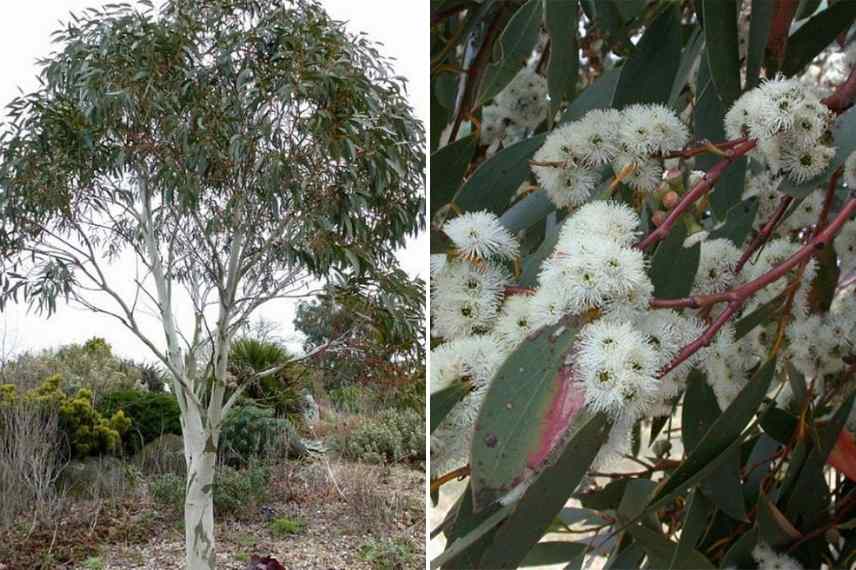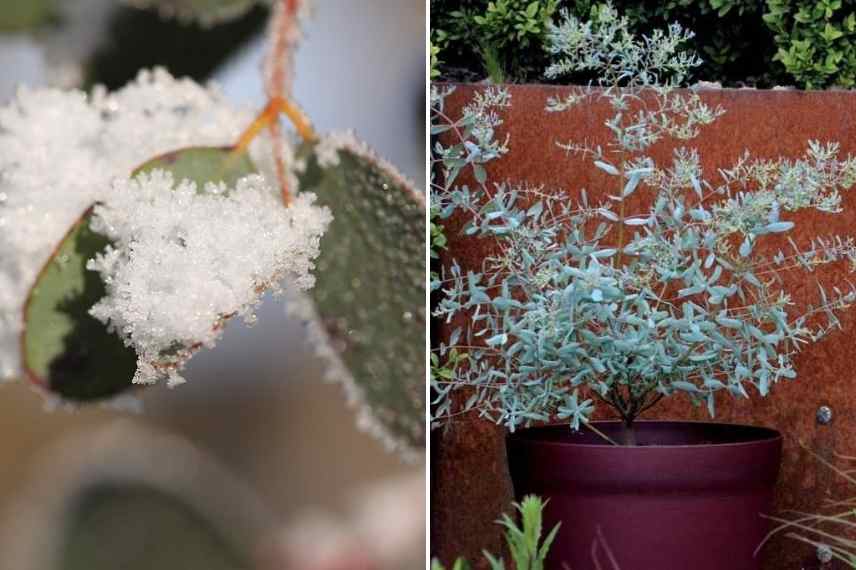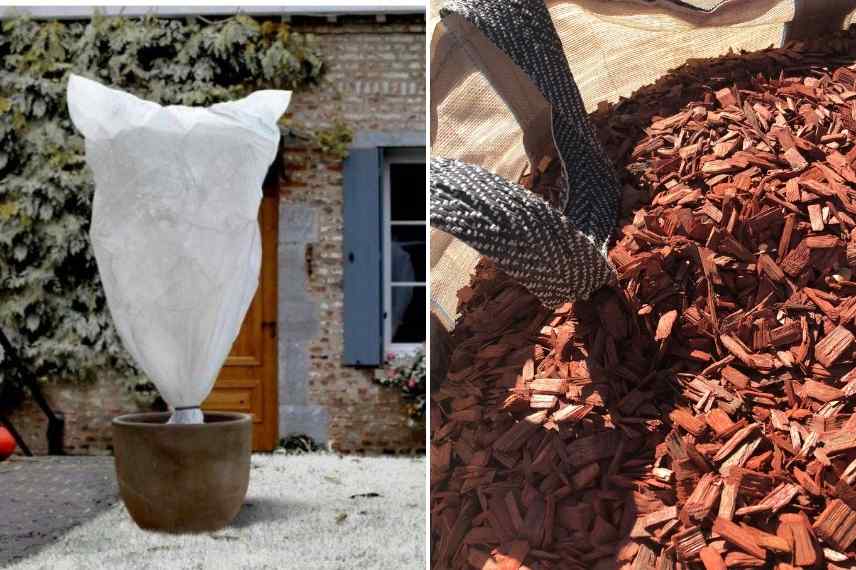
Eucalyptus: how to protect it from winter cold?
In the ground or in a pot
Contents
Eucalyptus or gum tree is a very decorative tree or bush with its evergreen, aromatic foliage, often blue-grey. Attractive all year round, it can be grown in the ground or in a large container to adorn a terrace. Not all eucalyptus have the same hardiness. If the ideal climate for this small tree is coastal or southern France, such as Brittany and the Côte d’Azur where frosts are mild and short-lived, the hardiest, such as the Snow Gum, can be planted in our regions with harsher winters provided drainage is good and they are protected from severe cold in winter, especially during the first years.
Discover all our tips to protect your eucalyptus from cold, whether you grow it in a pot or in the ground!
→ Discover our complete fact sheet on Eucalyptus

Eucalyptus under snow -© Amanda Slater)
More or less hardy varieties
Native mainly to Australia, Eucalyptus favours coastal climates or those of southern France, where frosts are mild and short-lived. But on closer inspection, they are not reserved solely for our mildest climates and you can therefore grow them in open ground in most of our regions, provided they have good winter protection. Generally, they can withstand below-freezing temperatures for short periods, but are vulnerable to frost when it persists. Varieties we offer are generally selected for their hardiness.
Hardiness of species is quite variable. Eucalyptus niphophila or Snow gum and Eucalyptus parviflora are among the hardiest, their cold tolerance reaching -18/-20°C when planted in well-drained soil. They also tolerate snow. Eucalyptus gunnii ‘Azura’ is a new variety notable for its excellent hardiness down to -15°C. Eucalyptus gunnii ‘Silverana’ is another variety that tolerates short frosts down to -10°C. By contrast, some dwarf varieties such as Eucalyptus pulverulenta ‘Baby Blue’ or Eucalyptus gunnii ‘France Bleu Rengun’ barely tolerate temperatures below -10°C. They will therefore be grown in pots in cooler regions and overwintered for maximum frost protection.
→ further reading: “Hardy plants and hardiness”

Among the hardiest: Eucalyptus niphophila and Eucalyptus parviflora
Overwintering a potted eucalyptus
When to bring pots indoors?
If you live in an area where frost is frequent and severe, prefer planting in a pot that can be brought in for winter. From autumn onwards, think about bringing your pots under cover to protect them from frost. Potted Eucalyptus should be sheltered before frosts occur, i.e. from mid-October in northern France and around mid-November in the south of the country. It is preferable to overwinter them when climate becomes cold and damp, even if it has not started to freeze yet.
Where and how to overwinter?
Place it in a conservatory, an unheated greenhouse, a winter garden or a frost-free room. Position the pot in a bright spot. You can take it back out in spring as soon as frost risk has passed, from March to May depending on region.
During this resting phase, reduce watering to once every fortnight until February–March to avoid the substrate drying out completely. Stop feeding.
In mild regions, if temperatures do not fall below about -10°C, you can leave your potted Eucalyptus outdoors for the winter. Depending on varieties, they will tolerate more or less severe frosts. Bear in mind that potted specimens are more vulnerable to bad weather and frost than those planted in the ground.
- Protect the pot entirely with cardboard, bubble wrap or hessian to insulate the roots from cold.
- Wrap the aerial parts with a winter fleece without breaking the branches.
- Place the pot in the most sheltered spot on the balcony, terrace or in the garden, for example at the foot of a well-exposed wall. In spring, remove these protections gradually. When temperatures warm up, take off the winter fleece for a few hours to aerate the branches and let the plant breathe.
- At the end of overwintering, repot the specimen into a free-draining, rich, humus-bearing and light substrate. Add an organic fertiliser and resume watering gradually.
- If necessary, to contain growth, prune moderately by removing dead or weak branches.
→ Read also: Growing an Eucalyptus in a pot

Discover other Eucalyptus
View all →Available in 1 sizes
Available in 1 sizes
Available in 1 sizes
Available in 1 sizes
Available in 1 sizes
Available in 1 sizes
Available in 1 sizes
Available in 2 sizes
Available in 1 sizes
Available in 1 sizes
Protecting eucalyptus planted in the ground
When to protect it?
As long as weather stays mild and dry, your plant is safe. In regions with mild winters, Eucalyptus can remain in ground. As a precaution during the first years because it is more fragile and as long as its pruning allows, it should be given winter protection.
How to protect it?
- To keep its roots warm and especially if you live in an area subject to severe frosts, mulch the stump with a thick layer of straw or dead leaves.
- Wrap the aerial parts with a winter fleece, securing it well around the base of the trunk. Ventilate regularly on days when there is no frost by temporarily removing the fleece. As soon as temperatures become milder and frost risk has passed, you can remove this protection.
- Reduce watering, while ensuring you never let the roots dry out. Stop all fertilisation.

Read also
Eucalyptus: planting, pruning and careMy eucalyptus has been damaged by frost — what should I do?
If, after severe frosts, shoots of your eucalyptus have been scorched, don’t worry! When temperatures are milder, prune it severely: pruning right down to ground level will allow stump to regrow.

Eucalyptus (© Tony Kent)
- Subscribe!
- Contents










































Comments